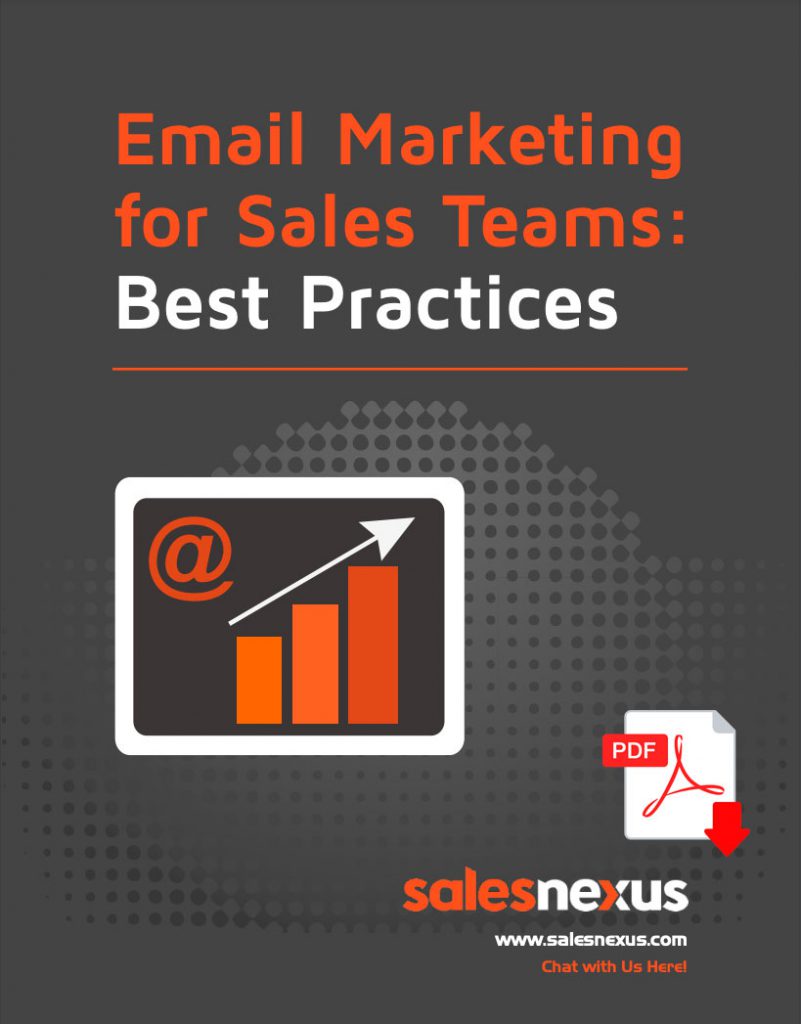Email marketing is not one thing. There’s a lot that goes into it. The most effective emails are those that are created with a very specific purpose and a very targeted audience in mind. Small and medium sized businesses often miss the mark with email marketing. Of course, so do the big guys. The causes are common, easy to identify and fix!
That’s good news because the return from very simple email marketing campaigns can be tremendous! Most sales organizations have accumulated a sizable list over the years and a well-designed campaign can often generate 15% to 25% increase in sales quickly!
A well-designed email marketing campaign can often generate 15% to 25% increase in sales quickly!
Running the numbers
Average email marketing campaigns get a 1-2% click rate. “Clicks” are people that both open and read the email AND click on a link or call to action in the email. Imagine a salesperson talks to 100 leads a month. In one year, that’s 1200 leads. If you have 10 salespeople, that’s 12,000 leads in a year. If your email to that list gets a 2% click rate, that’s 240 (12,000 x .02) “new” or newly engaged leads.
So, if you send only 1 email a month, then that’s a 24% increase in leads for each salesperson!
| Average campaign click rate | 1-2% |
| Salesperson 100 calls a month | 1,200 lost leads in one year |
| 10 Salespeople 100 calls a month | 12,000 lost leads in one year |
| 2% Click rate on 12,000 leads | 240 engaged leads |
| 1 Email sent per month | 24% Increase in leads per salesperson |
Seems like a no-brainer right?
Common pitfalls that undermine success are poor targeting, vague or absent call to action and talking about yourself, rather than the customer.
Often the lack of clarity about responsibilities and expected results is the fundamental flaw. In a smaller business, there may be a one person “marketing department” with limited email marketing experience and limited time to focus on it due to other responsibilities. So, the effort may fall to the sales team. And believe, salespeople are the last ones you want writing your emails! More on that later.
In a larger organization, the same flaws surface for different reasons. The salespeople may see opportunities they’d like to exploit with email marketing but, getting support out of the often bureaucratic marketing department can result in delays and distortions of the intent of the campaign.
Often the lack of clarity about responsibilities and expected results is the fundamental flaw.
Best Practices

In general, if the intent of email marketing is to drive sales or sales leads for the sales team, then the sales team needs to be involved in defining the objectives.
However, salespeople are most commonly guilty of writing “salesy” or “pitchy” emails. We need a marketing hat involved for the creation of the content.
We’re also going to need someone to get the list we send to straightened out. The list should be segmented and different messages sent to each segment. Again, this is not something the sales team is typically good at.
We’re also going to need someone to get the list we send to straightened out. The list should be segmented and different messages sent to each segment. Again, this is not something the sales team is typically good at.
Salespeople are commonly guilty of writing “salesy” or “pitchy” emails.
1st: Your List: Targeting Your Audience

The general concept is to offer recipients something that will be of value to them, without expecting them to do anything for you. That’s how you earn their trust and over time, the right to ask them for something. Email marketing is best done with this approach because if you just “sell” your products or services, you’ll quickly turn off most recipients and no one will be reading any of your emails anymore.
So, getting your list as finely segmented as possible is worth the effort. The more targeted your message to a specific audience, the more effective it will be.
- Pull together all the lists you can.
- Current leads that are actively in the purchase process
- Existing Clients
- Past Clients
You may need to pull together lists from your accounting system, operations, your website, trade shows, etc. and your salespeople’s contacts in Outlook, etc. If you’re doing this in a spreadsheet, be sure and add a couple of columns to identify where each contact came from or how you met them and what their current status is with your company.
If you’re using a CRM or other software for this, hopefully some of this is a bit easier. Either way, when you load the list into your email marketing system, you’ll be able to create separate lists based on all of these criteria and send different messages to each “segment”.
The tricky part is that you’ll need to maintain this list as an on-going effort
Obviously, when one of your leads turns into a client, you want them to go on a different list or into a different “segment”. That means you’ll need to have a regular process of updating the lists with new leads and changes to those already on the lists. This probably sounds like more work than it’s worth but, it’s not. Once you get a process in place, it should only take a couple of hours a month. If you’re lucky, you’re using a CRM and Marketing Automation solution where all that is automated!
One key to keeping the maintenance of your list manageable is to remember that no list is perfect. After all, you’re just sending them emails. With email marketing, there’s little cost to it and as we touched on earlier, you’re only hoping for 20% or so to even open them. So, there’s a point of diminishing returns in cleaning up your list. Just be sure you don’t have the same email address listed more than once and your actual clients are identified so you’re not treating them like you don’t even know them.
The general concept is to offer recipients something that will be of value to them, without expecting them to do anything for you.
2nd: Creating the Campaign

In email marketing, the idea to keep in mind is “Give to Get”. Give recipients something of value to them and earn the right first to keep sending them emails and secondly, the right to eventually ask for something yourself.
For the “dyed in the wool salespeople” out there, the fringe benefit of this approach is that this type of email marketing campaign is a great way to “diagnose” the customer’s needs. Those who click to read a specific article or watch a video are telling you what they’re interested in. That can be a great way to target prospects with specific offers, in additional emails or with sales calls. More on that later!
A simple approach to creating your emails is this:
List the Pains
Identify the “Pain” of each audience or “segment” in your list. Write down 3 or 4 pains (problems or challenges they suffer from) that this audience will have if they are going to be interested in your product or service. If you’re not sure how to do this, stop reading now and go here .
Finding Content
Find content that would be helpful to someone suffering from each pain. The content can be an article, a video, a blog post, a report or white-paper, etc. It should be free. Don’t ask them to complete a form on your site (you already have their email) or put any other barriers to benefiting from the content in the process. Remember, this is a gift!
Don’t get worried that you’re going to have to spend the next 3 weekends writing or spend thousands on a writer. In fact, avoid investing lots of time or money in creating content at all costs at this stage. If this is your first attempt, you have to look at it as an experiment. There are a lot of variables and many of them will need some adjustment. The idea initially is to get something out there so you can measure what works and what doesn’t and then make changes.
If this is your first attempt, you have to look at it as an experiment.
In fact, you don’t actually need your own content at all. If you have helpful articles or reports now that’s great! Things like “5 Ways to Reduce Your Costs for XXXX” or “3 Ways to Know if You Have YYYY” or even “How to Fix ZZZ” are all perfect. But, if you don’t already have good content, then use someone else’s!
A note on video: Email recipients will click on a video twice as often as other types of links (articles, downloads, etc.). So, use video if you can!
Go to Youtube and type into the search bar “How to fix <insert one of your pains>”. See if you can find a video that you can link to. Often you’ll find news reports or trade association videos that are perfect! Remember, the idea here is not get to them to your site. It’s just to give them something helpful and learn that they have an interest in that subject. Of course, you can perform similar searches on various sites and find government and educational institution reports, etc. Just be sure you don’t link to something that promotes your competitor!
For the “dyed in the wool” salespeople out there, the fringe benefit of this approach is that this type of email marketing campaign is a great way to “diagnose” the customer’s needs.
3rd: Writing the Email

In email marketing, the first thing to remember in creating the actual emails is that less is more. Think about how you navigate through your inbox. If you don’t recognize who sent you the email (the from field) then you look at the subject line. Likewise, if the subject line doesn’t sound interesting, you delete it without even reading the email. Moreover, if you do open it up and find 2 pages of text, DELETE!
What’s the point here? Keep it short! Also, don’t feel like you have to design a bunch of beautiful graphics.
So, the subject line is key. If it doesn’t get attention, nothing else matters.
Focus on the pain
- Is <insert your pain> costing you money/hurting your business/frustrating you?
- Fed up with <insert pain> solutions that don’t work?
- “Are you suffering from <insert pain>?
- 3 Ways to Fix <insert pain>
Follow the same formula to create the body of the email
Firstname,
Is <insert pain> costing you money/hurting your business/frustrating you?
If so, you’ll want to out this short video “Simple Ways to Fix <insert pain>”.
Then link to the content. That’s it!
Expectations
Remember, you’re going to get 10-20% of your list to open the email and 1-2% to click. Working on making that list bigger is worth the effort.
The emails above are great for “cold leads”, or leads that aren’t already engaged in a buying process. If you’re emailing leads that are already talking to your sales team or have reached out to you for information, then they’ve essentially told you to sell them your solution. The emails should still err on the side of “give to get” but, you can offer things like a comparison of your solution with brand name competitors or an ROI analysis or just a description of your different packages with a subject like “4 Great Ways to Fix <insert pain>”.
If you’re nurturing leads that have come in through your website, be aggressive. When people request info on your website, they’re most often doing the same exact thing on your competitor’s site so you’ve got to beat them to the punch.
NOTE: These types of emails also work well for lead generation campaigns.
Remember, you’re going to get 10-20% of your list to open the email and 1-2% to click
How to Respond – Making the Sale
If you’re selling business insurance and you send an email with the subject “3 Ways You’re Business is at Risk” that links to a video on CNBC about essential kinds of business insurance. A recipient opens the email and clicks on the video to watch it, which is a strong indicator that they’re raising their hand and saying “I am concerned that my business is at risk.” That probably makes that person someone your sales team wants to talk to.
If you can organize things so that a salesperson can call recipients that click on your emails within a couple of hours, then it is FAR better to call them instead of sending another email.
It turns cold calling into very warm calling! The script goes something like this:
“Hi Bob! This is Mike with Insurance International. I noticed you watched that video on essential business insurance. What did you think of that? What type of insurance does your business have?”
You can start the call with a level of familiarity and get right to what you already know matters to the customer. Salespeople know, the hardest thing about a cold call is getting the customers interest initially. This takes that out of the equation!
If you can’t call them within 3 or 4 hours, don’t bother
However, if you can’t call them within 3 or 4 hours, don’t bother. They won’t remember it. Think about how many emails you get every day. Do you remember on Wednesday, the links you clicked on Tuesday?
Again, an integrated CRM and Email Marketing solution can make this kind of quick calling easy. If it’s not realistic for you, then try switching those that click 1 or 2 of your initial content emails to a different campaign that treats them more like a new lead, providing some info about your company and how you solve the problems they’ve shown interest in and possibly requesting an appointment.
Have a follow up email ready for your sales team to send if they talk to the prospect or leave a voicemail. Normally, in the conversation or message they’re going to talk about things they’d like the prospect to see so, the email can link to those items and just get the conversation started.
It’s also worthwhile to call the people on your list that “bounce”. If they’ve left the company, you can find out who their replacement is and put them on your list.
However, if you can’t call them within 3 or 4 hours, don’t bother. They won’t remember it. Think about how many emails you get every day. Do you remember on Wednesday, the links you clicked on Tuesday?
4th: Email Marketing Campaign Management

Once you’ve got your first email marketing campaign going, compare the open rates for each subject line. Which ones are getting people’s attention? Focus your efforts on more content and emails in the same area. Don’t get stuck trying to make a subject or piece of content work that just isn’t. A lot of this is going to be counter-intuitive. Let the measurements tell you what to do next.
For the emails that get good opens, now look at the click rate. If you’re getting 10% or more opens and you’re not getting at least 1% click rate, then try moving the “call to action” (the link or video) higher up in the email so they see it more easily or try rewording the call to action itself. If that doesn’t work, then find new content.
Keep tweaking and adjusting. It may take you 2 or 3 iterations before you start to feel like you’re getting things dialed in.
Once you start seeing over 1% click rates consistently, then it’s time to start thinking about devoting some time to creating your own content and investing in a bigger list.
